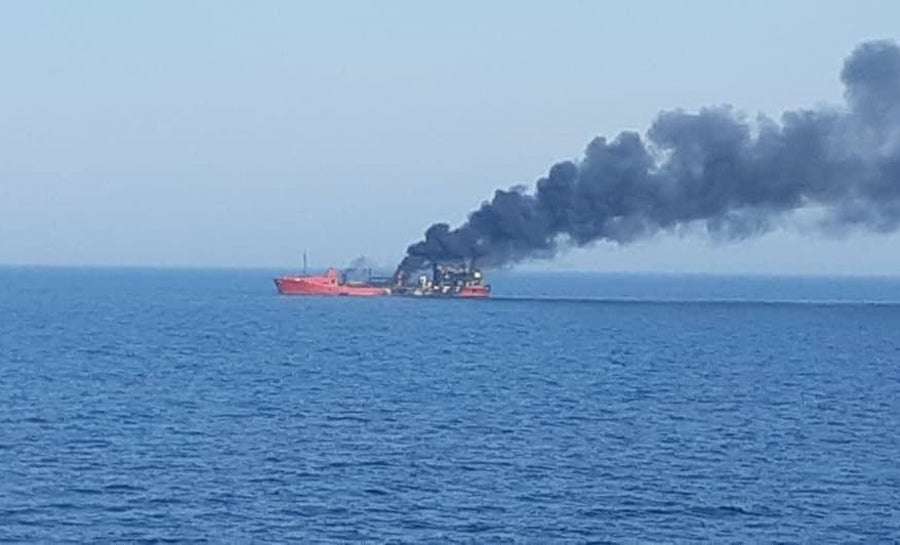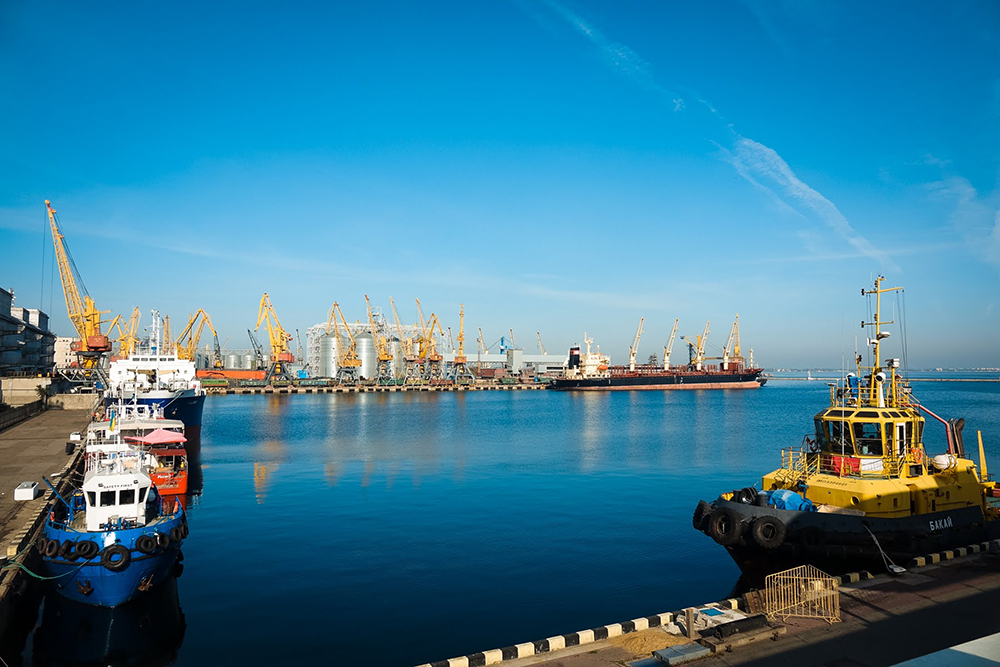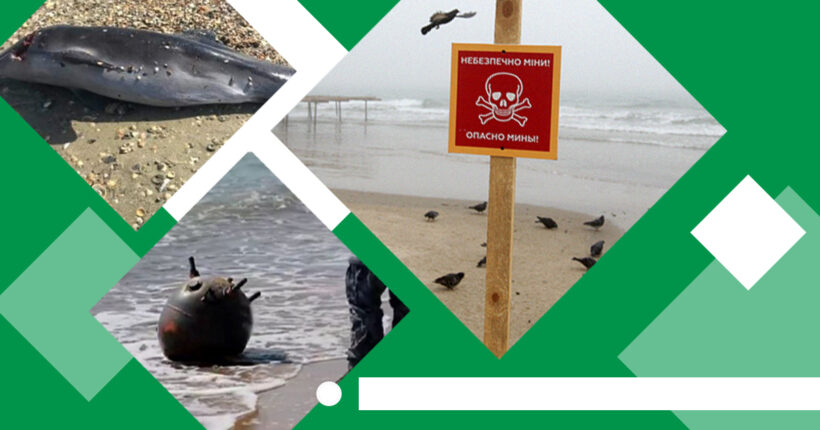
What is the problem?
Sea mining and explosions
In one of the interviews, the spokesperson of the Odesa governor's office, Serhii Bratchuk, once again drew attention to the fact that mining the Black Sea is a massive problem for both people and the environment. According to him, there are now several hundred mines in the water area, up to six hundred. Some of them are Ukrainian, stolen in Sevastopol by the russians back in 2014 after the occupation of Crimea.
After every storm, Bratchuk says, these anti-ship mines appear on the Black Sea coast; in particular, they have already been found several times on the coast of Odesa, which is already a threat to the lives of those who risked walking along the seashore. Some mines have already detonated: at the beginning of June in Odesa, a man was blown up by a mine on the beach, and on July 7, two more men were blown up by a mine on the coast of Odesa.
Explosions can also seriously threaten Ukraine's red-listed marine mammals, protected by many international conventions. For example, all three species of dolphins that live in the Black Sea are listed in the Red Book, but dead individuals are increasingly found on the coast. Thus, Iryna Vykhrystiuk, the Tuzly Lagoons National Park director, told Rubryka how the park inspectors recently found a dead dolphin with burnt skin; this happened probably, due to the explosion of an underwater bomb. At the same time, dead dolphins are found not only on the Ukrainian coast. Isolated cases were recorded in the northwestern part of the Black Sea, in this part's Romanian and Ukrainian sectors. Scientists from Turkey and Bulgaria also recorded many dead or disoriented dolphins that washed up on the seashore this year.
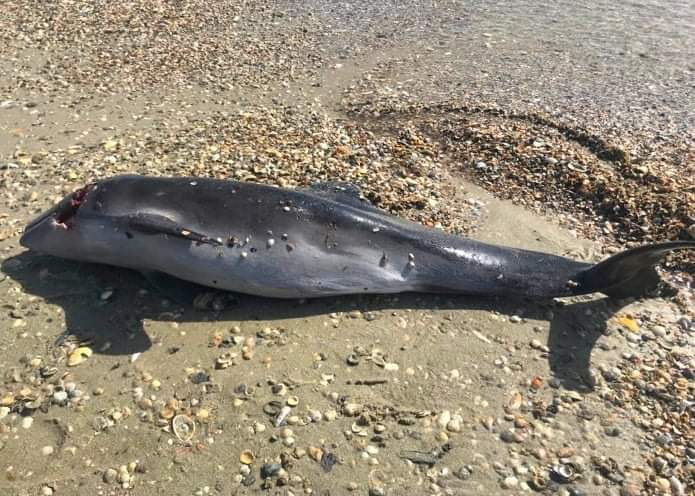
Photo: a dead dolphin on the coast, found by the Tuzly Lagoons employees. Source: the national park's Facebook page.
In addition, we have already pointed out that during the explosions of military shells, a vast amount of dangerous substances are released into the environment, both for humans and other living organisms nearby. Specialists of the Ecodia non-governmental organization explain that some munitions may use very toxic chemical compounds, such as white phosphorus, which releases poisonous gas and causes burns when ignited, and poisons soil and water if it gets into the environment. Phosphorus is practically insoluble and can be stored for decades in salty seawater under conditions of oxygen deficiency. Many compounds developed as chemical warfare agents that are highly toxic to humans are also harmful to other vertebrates at high concentrations. They can affect some aquatic organisms and accumulate and persist for years in the natural environment. Therefore, chemical pollution, including water resources, is another war companion.
The danger is not only explosions but also ships that remain permanently at sea. For example, the sinking of russia's Moskva cruiser, which, of course, was good news for all Ukrainians, may turn out to be disastrous for the ecosystem of the water area. Some researchers are concerned that specialized vessels went around the cruiser after the ship went to the bottom, so there are fears that among other munitions, Moskva also contained nuclear ones.
Oil and fuel spills
Reuters called the missile hitting the Moldovan-flagged tanker Millennial Spirit, which had been drifting in the Black Sea for more than four months, an "ecological bomb." The vessel transported diesel fuel:
"The shelling of tankers creates hazardous situations," the leading researcher of Schmalhausen Institute of Zoology Pavlo Holdin comments. "We know about the shelling of tankers in the waters of Ukraine, and I also saw on the fire map that a similar event could have happened in the open sea in the waters of Romania, which was not reported in the mass media. There may be several such tankers, and if they are damaged, there may be large spills," the scientist comments.
The damage from diesel fuel entering water is no less than from crude oil spills, although the consequences of both products are similar:
"It is a heavy fraction, so diesel tends to settle to the bottom. The speed of its distribution in the water changes depending on the season. Now it's summer, it's hot, and diesel will settle slowly and at the same time spread in the water," the scientist explains to Rubryka.
Ivan Rusiev, acting director of the Tuzly Lagoons Nature Park, said in a conversation with Rubryka that he is sure that oil continues to enter the sea due to infrastructure destruction and damage to ships. He says there may be a small amount even near the Tuzly estuaries. This damage is hazardous because the oil covers the water layer with a thin film that blocks oxygen access to the water. As a result, algae don't receive enough light to produce oxygen, and fish and fry die, which live and feed almost on the sea's surface. Leading researcher of the Schmalhausen Institute of Zoology Pavlo Holdin explains that any oil spill has some negative consequences for the environment. First, it harms tiny organisms and plankton that float in the water. It can also lead to the death of fish, and harm oil spills and birds, which suffer by falling into "oil stains."
Oil tends to sink below the water level and form "clouds" of droplets below the surface. It is challenging to collect such oil, and sometimes environmentally dangerous methods are used to dispose of it, such as, for example, burning. However, we cannot do even it now:
"In conditions of war, no one will collect oil because now the safety of people—both military and civilians—is the priority, and there are quite strict restrictions. The activities of people at sea and on land, especially civilians, are very, very limited," says Pavlo Holdin.
Pathogens of diseases in the sea
The factors of marine biota mortality also include pathogens that can get into the sea as a bacteriological weapon or accidentally due to damage to the city sewer or, say, an agricultural complex. Scientists discovered this pollution mechanism even before the start of a full-scale war—the russians deliberately, in a brutal way, polluted their water areas and international waters, dumping sewage from agricultural farms in the Krasnodar Territory into the sea, which caused dolphins to get toxoplasmosis.
Fires on the coast
Another problem is that coastal ecosystems are being destroyed by fires that rescuers cannot extinguish due to possible shelling; according to preliminary data, the fire has covered 130 hectares on the Kinburn Spit alone. Areas of forest ecosystems have been lost; rare species of animals and unique sand flora have been destroyed and damaged; birds listed in the Red Book have lost places suitable for nesting.
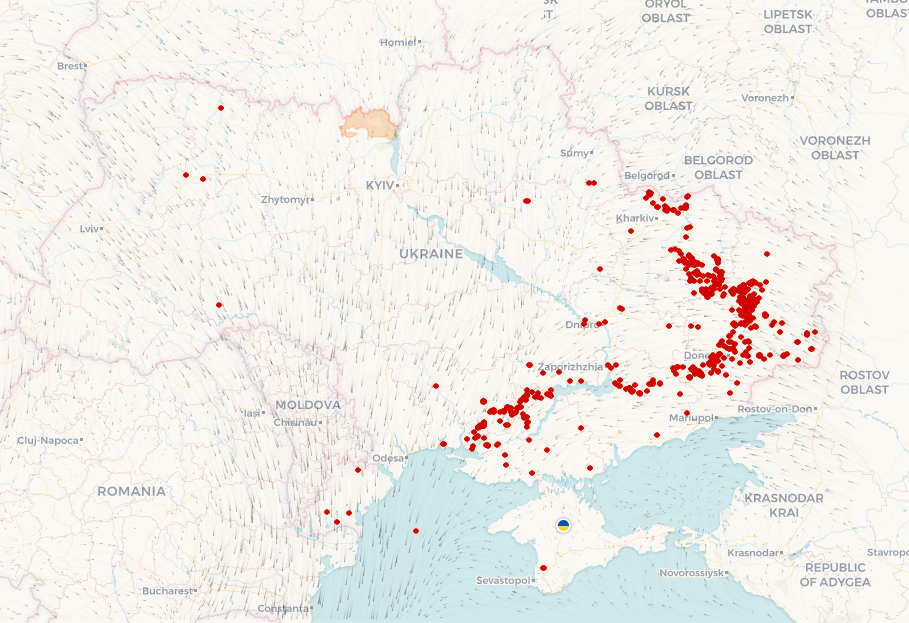
Centers of fires on the territory of Ukraine. Source: SaveEcoBot fire map
Оccupation and environment
The natural heritage of Ukrainians—national parks and natural biosphere reserves—also suffers from the war. There is only one national natural park on the Black Sea and Azov coasts that the russians do not occupy—Tuzly Lagoons Nature Park. Azov-Syvash Park, Dzharylhach Park, and Meotyda Park are under occupation. Due to the war, proper protection is impossible in the occupied territories. The state must protect these territories—inspectors and park employees must go around the parks to record environmental changes, fight poachers, etc. In the non-occupied ones, it is weakened because there is the insufficient staff: most of the inspectors are now in the army.
As for monitoring the ecological situation on the Azov coast, nothing can be said here since the territories are occupied, and contact with local specialists has been lost. It is probably still impossible to find out what is happening to the biota in the Sea of Azov after the heavy shelling of Azovstal, located right on the seashore, and whether dangerous chemicals have reached the sea.
What is the solution?
First, demining
The first thing to do is to clear the sea of mines. In this case, Ukraine needs help because the mines in the water are not stable and are not in one place—they drift in the waters and can be carried to the coasts of other countries, for example, Bulgaria, Romania, or even Turkey. Serhii Bratchuk, the spokesperson of the Odesa region, pointed this out:
"Ukraine will not be able to demine [the sea, — ed.]. Not because Ukrainians are stupid or because we don't know how to do something. No, we are smart and have specialists, but we do not have many means to carry out this military operation ourselves. Therefore, we hope that Ukraine will get help from partner countries. We hope for Romania, Bulgaria, and Turkey because it is our common Black Sea. A mine was destroyed a few days ago near Varna [Bulgaria, ed.]. In March, it was near Turkey and Romania. That is, it will be a common problem," says Bratchuk.
Assessing the effects of war on the environment
However, since mines are not the whole problem, scientists are joining in. Ukrainian scientists have created a collegial community—the Operational Headquarters of Ukraine's state environmental inspectorate. It unites scientists and experts from various disciplines: oceanographers, climatologists, biologists, economists, etc. The headquarters includes a large number of Ukrainian institutes: institutes of the Academy of Sciences, departmental institutes of the Ministry of Natural Resources, universities, independent non-governmental institutions, as well as foreign partner institutions. The task of the headquarters is to create methods they can use to assess the effects of war on the environment, which Ukraine can take to court. However, scientists have not yet provided preliminary estimates:
"Every day, we come across some new incidents," says the staff expert, leading researcher of Schmalhausen Institute of Zoology Pavlo Holdin.
Situation monitoring and aerospace photography
The difficulty of recording data in the occupied territories also has a specific solution. Indeed, Ukrainian experts and specialists are not allowed on the Azov coast, but there are satellite systems that can record fires on land and at sea, the movement of equipment, etc. The Ministry of Ecology of Ukraine was able to use the images of the aerospace imaging system with the cooperation of the State Space Agency last year. Specialists use archival and operational photos from different dates, select the necessary areas and, with the help of software transformations, conduct a retrospective analysis by comparing space images from specific times. Further, the information obtained from the space data regarding the detected changes is compared with the materials of the permit documents. Initially, the government created the system to record illegal logging, but now the functionality has been expanded, and specialists can also monitor the condition of coasts.
It is not our only functionality. Now, even NASA provides images when the world is looking at Ukraine. Commissioner for the Environment Virginijus Sinkevičius recently stated that the EU gave Ukraine additional opportunities to use the Copernicus satellite system of the European Union to record russia's environmental crimes.
Nanosponges to collect oil
It is also possible to collect oil. In 2017, American scientists from the Argonne laboratory invented the Oleo Sponge technology. The invention resembles ordinary sponges for washing dishes, but the human eye cannot see the most important thing: this technology works at the nano-level. Oxidized metal atoms with complex nanostructures penetrate the sponge's fibers, allowing it to combine with oil in water, separating these liquids effectively. Sponges not only clean water from oil but also store raw materials. Collected oil can be used again in production after "squeezing" the sponge. The sponge itself can be reused.
This technology, scientists say, is safe for the environment, unlike other methods: modern sorbent technologies absorb oil for single use, and then the oil-saturated materials must be disposed of. But Oleo Sponge's approach is environmentally friendly and doesn't harm marine life, animals, or the environment—a key advantage over chemical dispersants or incineration methods used today.
Our team wrote to the laboratory office to find out whether it is possible to apply such technology in the waters of the Black Sea, but we haven't yet received an answer. Follow our updates and wait for new articles to find out how we will have to save nature in the coming years.
Newsletter
Digest of the most interesting news: just about the main thing




